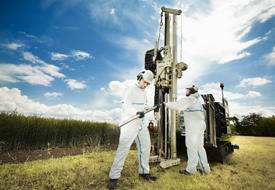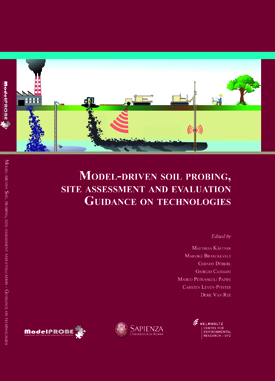Press release, 24 September 2012
New methods might drastically reduce the costs of investigating polluted sites
Ferrara/Leipzig. New methods might allow polluted sites to be investigated and monitored long term at significantly reduced costs. Authorities and those who have to remediate polluted sites in Europe might therefore be able to save costs and use these to treat other areas. This is the conclusion of the EU research project ModelPROBE, which was coordinated by the UFZ and the results of which were presented to the public on Friday 21, September 2012 at the international REMTECH Expo exhibition in Ferrara, North Italy. The results, with which the scientists aimed to lower the workload of authorities and consultants, include a handbook detailing the methods for characterising contaminated sites and a freely-accessible e-learning course.
 Two employees of the UFZ in the study of groundwater, using direct push technology. This is one of several technologies that allow, in combination, contaminated sites to explore more effective and to save costs.
Two employees of the UFZ in the study of groundwater, using direct push technology. This is one of several technologies that allow, in combination, contaminated sites to explore more effective and to save costs.
Photo: André Künzelmann / UFZ
In Europe there are over 20,000 complex and large contaminated areas. These so-called megasites threaten scarce land and water resources, create environmental and health risks and result in economic and social costs. Their efficient and sustainable revitalisation requires innovative site assessment and decontamination technologies and integrated evaluation approaches in order to optimise the options for their re-use. A total of 15 partners from eight countries have therefore developed within the scope of the EU ModelPROBE (Model driven Soil Probing, Site Assessment and Evaluation) project new methods for the assessment of polluted sites and the associated monitoring of rehabilitation measures. These methods, which are non- to low-invasive in terms of sampling and treatment of the subsoil at all, were tested, reviewed and compared with traditional methods at UFZ reference sites such as in Zeitz. The EU has funded this inter-disciplinary monitoring to the tune of EUR 3 million.
In order to detect pollution in the subsoil, until now for the most part samples of soil and groundwater have been taken. Pollution may only be detected, however, if the samples are taken at the optimum points and in a sufficiently dense measurement network. Their accuracy determines how well the pollution can be detected. The scientists have therefore worked on time-delayed geophysical measurements in order to improve the accuracy of the probing and also to record the effects of hydraulic changes and microbial activity. The ModelPROBE project also integrates new methods with which important information on pollution in the soil can be gained for example by analysing the vegetation. Based on these non-invasive site-investigation methods, the extent of the contamination and the heterogeneity of the subsoil are then localised. “Using direct push probes with linked geophysical and hydrological probing systems and combined with chemical, toxicological and isotope analyses, so-called hot spots are then monitored in order to determine the limits of and identify the contaminated area without fear of legal action,” explains the project coordinator Prof. Matthias Kästner of the Helmholtz Centre for Environmental Research (UFZ). Biological processes such as pollutant decomposition and toxic effects at the site are monitored using passive samplers, biosensors and microcosms with subsequent isotope and biomarker analyses. Due to this complex monitoring process, scientists not only from the Environmental Biotechnology Department, but also from the Groundwater Remediation, Monitoring & Exploration Technologies, Bioanalytical Ecotoxicology and Isotope Biogeochemistry Departments were involved.
These methods were tested not only in Zeitz, but also by project partners in Italy, Norway and the Czech Republic. The aim was to gain a fresh insight into soil and subsoil contamination at different levels including integrated statistical analysis and modelling and to provide a solid foundation for future risk assessments and sustainable rehabilitation concepts.

Publications
E-Learning:
http://modelprobedisseminationsystem.com/
Book:
M. Kästner, M. Brackevelt, G. Döberl, G. Cassiani, M. Petrangeli Papini, C. Leven-Pfister & D. van Ree Eds (2012): MODEL-DRIVEN Soil probing, site assessment and evaluation – Guidance on technologies. ISBN 978-88-95814-72-8.
In line with the principles of public promotion by the EU, the manual can be obtained for free from the Environmental Biotechnology Department of the Helmholtz Centre for Environmental Research (UFZ); there is a processing and postage charge of € 25.
Other technical information
Helmholtz Centre for Environmental Research (UFZ)
Prof. Dr. habil. Matthias Kästner
phone: +49-341-235-1235
http://www.ufz.de/index.php?de=4459
or via
Tilo Arnhold (UFZ Press Office)
Phone: +49-341-235-1635
Links with further information
project ModelPROBE:
http://www.modelprobe.ufz.de/index.php?en=18269
At the Helmholtz Centre for Environmental Research (UFZ) scientists are researching the causes and consequences of far-reaching changes to the environment. They are concerned with water resources, biological diversity, the consequences of climate change and adaptability, environmental and biotechnologies, bioenergy, the behaviour of chemicals in the environment, their effect on health, modelling and social science issues. Their guiding theme: Our research contributes to the sustainable use of natural resources and helps to secure this basis for life over the long term under the effects of global change. The UFZ employs 1,000 people in Leipzig, Halle and Magdeburg. It is financed by the federal government and the federal states of Saxony and Saxony-Anhalt.
http://www.ufz.de/
The Helmholtz Association contributes towards solving major and pressing social, scientific and economic issues with scientific excellence in six research areas: Energy, Earth and Environment, Health, Key Technologies, Structure of Matter, Aeronautics, Aerospace and Transport. The Helmholtz Association is Germany’s largest scientific organisation with over 33,000 employees in 18 research centres and an annual budget of approximately 3.4 billion euros. Its work stands in the tradition of the naturalist Hermann von Helmholtz (1821-1894).
http://www.helmholtz.de
